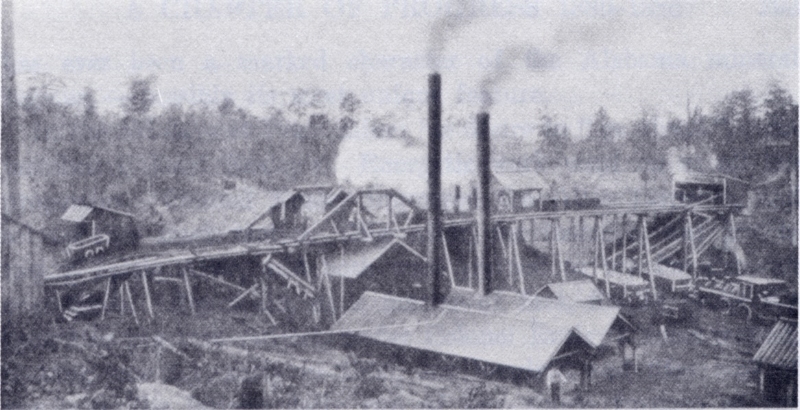Eureka Company
Work will continue in researching the tramway. But what of the furnace complex itself?
Woodward's "Alabama Blast Furnaces" has a good summary of the history of Oxmoor, or Ironton as it was apparently first called. The Alabama Department of Archives and History have several vintage images of the furnace complex dating from the time of the rebuilding in 1872.
|
Woodward tells us that the Red Mountain Iron and Coal Company, successor to the Alabama Arms Manufacturing Company started two, but completed (only) one furnace during the War. It was finished in the late fall of 1863. In the waning days of the War, Wilson's raiders hit Oxmoor on March 30 and "burned all the wooden buildings and destroyed the machinery. ...The plant remained in wrecked condition until sometime in 1872 when the Eureka Mining and Transportation Company was organized to take over the old Red Mountain Company." Woodward goes on to say the furnace(s) were rebuilt and were enlarged from 9 or 10 feet in the bosh by 32 feet high, to 60 by 12 feet. Additional height was achieved by superimposing an iron cylinder on top of the stone furnace. In addition, a "bell and hopper" assembly was added -- this enabled material to be more evenly distributed during charging. This image, then, appears to be taken in 1872, with the vertical cylinders on top of the stone bases.
|
|
|
The improvements to the furnaces did not produce the anticipated increase in production -- operation was an art rather than a science, and the operators may have lacked experience according to Woodward: "The furnaces were blown in on a mixture of half charcoal and half coke. Coal was obtained first from the Helena mines and coked in much the same way that wood was converted to charcoal, in shallow pits covered with dust." "A narrow gauge railroad of two and one-half miles was constructed to the ore mines and ten charcoal ovens of 2500 bu[shel] capacity each were built at the furnaces to supplement the outside supply." Based on this, it would appear that these beehive ovens were built for charcoal rather than coke production. In this image, ovens 7 and 8 are under construction, and two are yet to be built. Woodward indicates that the "improved" operation of 1872 was short-lived, due to the financial Panic of 1873 which caused a shut down until a lessor, James Thomas and Co. began operation again in 1875. |
|
|
This idea that these are charcoal ovens, rather then coke ovens, seems plausible and consistent with Woodward's account -- the beehives are shown in this image amidst a great deal of cut timber. This is presumed to be for the production of charcoal. Thus the caption of these images as "coal ovens" seems confusing, unless one considers that the writer believed that "char -- coal" was the reference. Further, the caption of this image uses odd wording referring to the "coal wood" yard. Could the writer have been someone who did not understand the terminology being used? |
|
|
This image is from Armes, and shows the Helena Coal Mines in 1878. In the lower right, one may see a railroad locomotive which is presumed to be the way that coal was taken to the furnaces at Oxmoor. Woodward tells us that after the successful production of coke pig iron at Oxmoor in 1876, that "the mines in Helena increased in capacity and 100 beehive ovens were constructed there. A small battery of Belgian coke ovens was also erected at the furnace to coke Cahaba coal." |
 |
 |
|
|
This image is a combination which indicates that the camera location is very similar for both. This gives a better feel for the layout of the site at Oxmoor, and the relationship of the charcoal ovens to the furnace complex and other buildings. The question of orientation and layout will be addressed more in the following pages. Continue to next page |
|